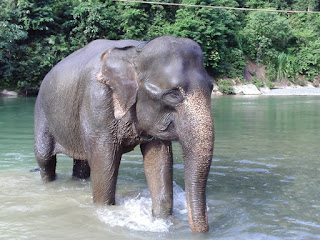Animal Wildlife | Sumatran Elephant | The Sumatran elephant is a sub-species of Asian elephant which includes the Indian elephant, the Sumatran elephant, the Sri-Lanka elephant and the Borneo elephant. The Sumatran elephant is extremely rare today, with estimates in 2000 putting Sumatran elephant numbers at just over 2,000 individuals. As its name suggests, the Sumatran elephant is found exclusively on the Indonesian island of Sumatra. However, the Sumatran elephant population has severely declined as they have lost more than 80% of their natural habitat to deforestation for palm oil plantations.
The Sumatran elephant has smaller ears than the African elephant and the Sumatran elephant also has a more curved spine than the African elephant. Unlike the African elephants, the female Sumatran elephants very rarely have tusks, and if the female Sumatran elephant does have tusks, they are generally barely visible and can only be seen when the female Sumatran elephant opens her mouth. The Sumatran elephant follows strict migration routes that are determined by the monsoon season. The eldest elephant of the Sumatran elephant herd is responsible for remembering the migration route of its Sumatran elephant herd. This Sumatran elephant migration generally takes place between the wet and dry seasons and problems arose when farms where built along the migratory routes of the Sumatran elephant herds, as the Sumatran elephants caused a great deal of destruction to the newly founded farmland.
Sumatran elephants are herbivorous animals meaning that they only eat plants and plant matter in order to gain all of the nutrients that they need to survive. Sumatran elephants eat a wide variety of vegetation including grasses, leaves, shoots, barks, fruits, nuts and seeds. Sumatran elephants often use their long trunk to assist them in gathering food. Due to their large size, Sumatran elephants have very few predators within their natural environment. Besides human hunters, Sumatran tigers are the primary predator of the Sumatran elephant, although they tend to hunt the smaller Sumatran elephant calves rather than the much larger and stronger adults.
Female Sumatran elephants are generally able to breed by the time they are 10 years old, and give birth to a single Sumatran elephant calf after a 22 month gestation period. When the Sumatran elephant calf is first born, it weighs about 100 kg, and is cared for not only by it's mother by also by other female Sumatran elephants in the herd (known as aunties). The infant Sumatran elephant remains with its mother until it is around 5 years old and gains its independence, with males often leaving the herd and female calves staying.
Today, the Sumatran elephant is considered to be an animal that is in immediate danger of becoming extinct due to the fact that Sumatran elephant populations have been declining at a critical rate. Sumatran elephants are thought to be suffering primarily due to habitat loss in the form of deforestation and hunting for their ivory tusks by human poachers. - ANIMAL WILDLIFE
Tags: elephant van insurance, home insurance elephant, elephant home insurance, elephant breakdown cover, elephant travel insurance, elephant auto insurance, elephant auto, elephant loan, elephant windows, brown elephant chicago, elephant toothpaste, elephant loans, elephant bark, elephant car hire, elephant bike insurance, elephant skin disease, elephant self storage






0 Response to "Sumatran Elephant"
Post a Comment